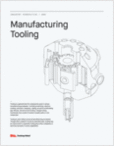 | Challenge When a manufacturer gets a drawing or CAD model for a new product, the first thing that must be done is plan how the part will be manufactured—this plan almost always requires creating tooling. Many forms of tooling require materials with excellent hardness, wear, resistance to thermal cycling, and lifetime. While tool steels possess those properties, they can be very difficult to manufacture. Their high hardness makes machining them expensive and time-consuming due to the slow cutting rates and high tool wear. Solution Additive manufacturing dramatically simplifies the process of creating tooling and fixturing. With no dedicated operator needed to monitor 3D printing systems, manufacturers can simply upload their designs to the printer, and finished tooling will be ready to use in days, making it faster to stand up manufacturing lines. Printing parts makes it easier to create tooling from difficult-to-machine materials like tool steel. Since 3D printed parts are not machined from a single block of metal, but created layer by layer, near net-shape parts can be created without waste. Printed tooling also enables new, higher-performance designs which could not be created or justified with traditional manufacturing. Lightweighting features – which would normally add significant cost - can easily be fabricated via infill or cutouts. Those features reduce part costs and processing time - less material equals faster prints and less material costs. Read this eBook to learn more. Request Free! |
